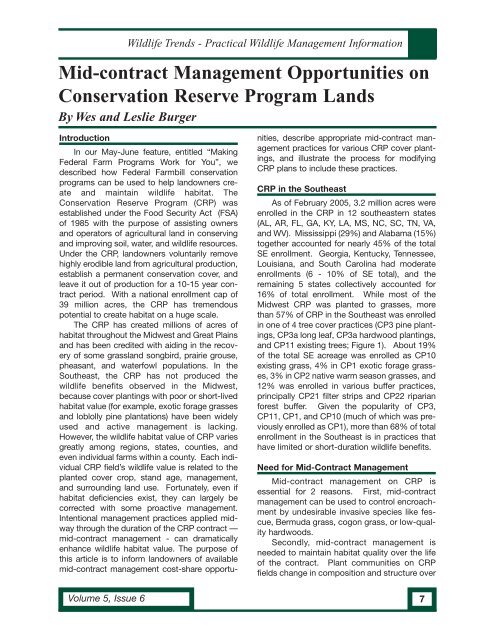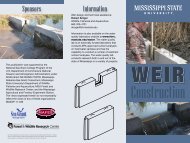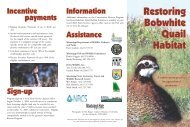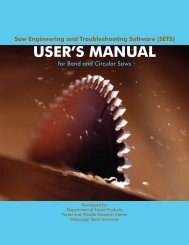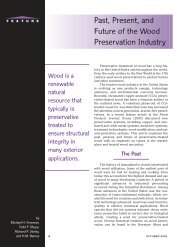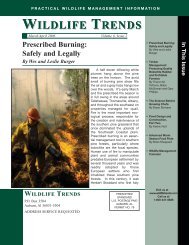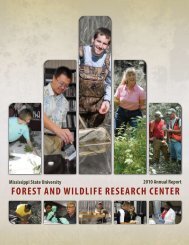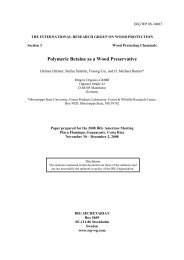Mid-contract Management Opportunities on Conservation Reserve ...
Mid-contract Management Opportunities on Conservation Reserve ...
Mid-contract Management Opportunities on Conservation Reserve ...
Create successful ePaper yourself
Turn your PDF publications into a flip-book with our unique Google optimized e-Paper software.
Volume 5, Issue 6<br />
Wildlife Trends - Practical Wildlife <str<strong>on</strong>g>Management</str<strong>on</strong>g> Informati<strong>on</strong><br />
<str<strong>on</strong>g>Mid</str<strong>on</strong>g>-<str<strong>on</strong>g>c<strong>on</strong>tract</str<strong>on</strong>g> <str<strong>on</strong>g>Management</str<strong>on</strong>g> <str<strong>on</strong>g>Opportunities</str<strong>on</strong>g> <strong>on</strong><br />
C<strong>on</strong>servati<strong>on</strong> <strong>Reserve</strong> Program Lands<br />
By Wes and Leslie Burger<br />
Introducti<strong>on</strong><br />
In our May-June feature, entitled “Making<br />
Federal Farm Programs Work for You”, we<br />
described how Federal Farmbill c<strong>on</strong>servati<strong>on</strong><br />
programs can be used to help landowners create<br />
and maintain wildlife habitat. The<br />
C<strong>on</strong>servati<strong>on</strong> <strong>Reserve</strong> Program (CRP) was<br />
established under the Food Security Act (FSA)<br />
of 1985 with the purpose of assisting owners<br />
and operators of agricultural land in c<strong>on</strong>serving<br />
and improving soil, water, and wildlife resources.<br />
Under the CRP, landowners voluntarily remove<br />
highly erodible land from agricultural producti<strong>on</strong>,<br />
establish a permanent c<strong>on</strong>servati<strong>on</strong> cover, and<br />
leave it out of producti<strong>on</strong> for a 10-15 year <str<strong>on</strong>g>c<strong>on</strong>tract</str<strong>on</strong>g><br />
period. With a nati<strong>on</strong>al enrollment cap of<br />
39 milli<strong>on</strong> acres, the CRP has tremendous<br />
potential to create habitat <strong>on</strong> a huge scale.<br />
The CRP has created milli<strong>on</strong>s of acres of<br />
habitat throughout the <str<strong>on</strong>g>Mid</str<strong>on</strong>g>west and Great Plains<br />
and has been credited with aiding in the recovery<br />
of some grassland s<strong>on</strong>gbird, prairie grouse,<br />
pheasant, and waterfowl populati<strong>on</strong>s. In the<br />
Southeast, the CRP has not produced the<br />
wildlife benefits observed in the <str<strong>on</strong>g>Mid</str<strong>on</strong>g>west,<br />
because cover plantings with poor or short-lived<br />
habitat value (for example, exotic forage grasses<br />
and loblolly pine plantati<strong>on</strong>s) have been widely<br />
used and active management is lacking.<br />
However, the wildlife habitat value of CRP varies<br />
greatly am<strong>on</strong>g regi<strong>on</strong>s, states, counties, and<br />
even individual farms within a county. Each individual<br />
CRP field’s wildlife value is related to the<br />
planted cover crop, stand age, management,<br />
and surrounding land use. Fortunately, even if<br />
habitat deficiencies exist, they can largely be<br />
corrected with some proactive management.<br />
Intenti<strong>on</strong>al management practices applied midway<br />
through the durati<strong>on</strong> of the CRP <str<strong>on</strong>g>c<strong>on</strong>tract</str<strong>on</strong>g> —<br />
mid-<str<strong>on</strong>g>c<strong>on</strong>tract</str<strong>on</strong>g> management - can dramatically<br />
enhance wildlife habitat value. The purpose of<br />
this article is to inform landowners of available<br />
mid-<str<strong>on</strong>g>c<strong>on</strong>tract</str<strong>on</strong>g> management cost-share opportu-<br />
nities, describe appropriate mid-<str<strong>on</strong>g>c<strong>on</strong>tract</str<strong>on</strong>g> management<br />
practices for various CRP cover plantings,<br />
and illustrate the process for modifying<br />
CRP plans to include these practices.<br />
CRP in the Southeast<br />
As of February 2005, 3.2 milli<strong>on</strong> acres were<br />
enrolled in the CRP in 12 southeastern states<br />
(AL, AR, FL, GA, KY, LA, MS, NC, SC, TN, VA,<br />
and WV). Mississippi (29%) and Alabama (15%)<br />
together accounted for nearly 45% of the total<br />
SE enrollment. Georgia, Kentucky, Tennessee,<br />
Louisiana, and South Carolina had moderate<br />
enrollments (6 - 10% of SE total), and the<br />
remaining 5 states collectively accounted for<br />
16% of total enrollment. While most of the<br />
<str<strong>on</strong>g>Mid</str<strong>on</strong>g>west CRP was planted to grasses, more<br />
than 57% of CRP in the Southeast was enrolled<br />
in <strong>on</strong>e of 4 tree cover practices (CP3 pine plantings,<br />
CP3a l<strong>on</strong>g leaf, CP3a hardwood plantings,<br />
and CP11 existing trees; Figure 1). About 19%<br />
of the total SE acreage was enrolled as CP10<br />
existing grass, 4% in CP1 exotic forage grasses,<br />
3% in CP2 native warm seas<strong>on</strong> grasses, and<br />
12% was enrolled in various buffer practices,<br />
principally CP21 filter strips and CP22 riparian<br />
forest buffer. Given the popularity of CP3,<br />
CP11, CP1, and CP10 (much of which was previously<br />
enrolled as CP1), more than 68% of total<br />
enrollment in the Southeast is in practices that<br />
have limited or short-durati<strong>on</strong> wildlife benefits.<br />
Need for <str<strong>on</strong>g>Mid</str<strong>on</strong>g>-C<strong>on</strong>tract <str<strong>on</strong>g>Management</str<strong>on</strong>g><br />
<str<strong>on</strong>g>Mid</str<strong>on</strong>g>-<str<strong>on</strong>g>c<strong>on</strong>tract</str<strong>on</strong>g> management <strong>on</strong> CRP is<br />
essential for 2 reas<strong>on</strong>s. First, mid-<str<strong>on</strong>g>c<strong>on</strong>tract</str<strong>on</strong>g><br />
management can be used to c<strong>on</strong>trol encroachment<br />
by undesirable invasive species like fescue,<br />
Bermuda grass, cog<strong>on</strong> grass, or low-quality<br />
hardwoods.<br />
Sec<strong>on</strong>dly, mid-<str<strong>on</strong>g>c<strong>on</strong>tract</str<strong>on</strong>g> management is<br />
needed to maintain habitat quality over the life<br />
of the <str<strong>on</strong>g>c<strong>on</strong>tract</str<strong>on</strong>g>. Plant communities <strong>on</strong> CRP<br />
fields change in compositi<strong>on</strong> and structure over<br />
7
Wildlife Trends - Practical Wildlife <str<strong>on</strong>g>Management</str<strong>on</strong>g> Informati<strong>on</strong><br />
the 10-year life of the <str<strong>on</strong>g>c<strong>on</strong>tract</str<strong>on</strong>g>, in a process<br />
known to ecologists as successi<strong>on</strong> (see Figure<br />
2). Annual weed communities, characterized<br />
by grasses, annual forbs, legumes, and bare<br />
ground, dominate newly established CRP<br />
fields. These annual communities are shortlived,<br />
lasting <strong>on</strong>ly <strong>on</strong>e to two growing seas<strong>on</strong>s.<br />
CRP fields dominated by fescue provide low quality<br />
wildlife habitat.<br />
8<br />
Wetlands<br />
2%<br />
Existing Trees<br />
30%<br />
CRP in the Southeast<br />
Buffer Practices<br />
12%<br />
New Hardwood<br />
10%<br />
Rare & Declining<br />
0%<br />
Foodplot<br />
0%<br />
New L<strong>on</strong>gleaf<br />
6%<br />
Gradually, annual plants are replaced by perennial<br />
forbs, grasses, and eventually, woody<br />
plants. These changes in vegetati<strong>on</strong> compositi<strong>on</strong><br />
are also accompanied by changes in vegetati<strong>on</strong><br />
structure. As the plant community ages,<br />
bare ground declines, litter accumulates, and<br />
vegetati<strong>on</strong> density increases. In the Southeast,<br />
with l<strong>on</strong>g growing seas<strong>on</strong>s, warm temperatures,<br />
and high rainfall, natural successi<strong>on</strong> progresses<br />
rapidly.<br />
Successi<strong>on</strong> also occurs in CRP pine plantati<strong>on</strong>s<br />
(Figure 3). Herbaceous ground cover<br />
declines as the pines capture the site and close<br />
the canopy. Within 3-5 years after planting,<br />
loblolly and slash pine plantati<strong>on</strong>s provide little<br />
habitat for early successi<strong>on</strong>al wildlife. This<br />
state persists throughout the sapling and pole<br />
stage until the stand is thinned during mid-rotati<strong>on</strong>.<br />
Following thinning, the canopy is opened<br />
and sunlight hits the forest floor, stimulating<br />
germinati<strong>on</strong> of grasses, legumes and forbs.<br />
However, if periodic disturbance is not applied,<br />
invasive shade-tolerant hardwoods, such as<br />
sweetgum and hickory, will take over, blocking<br />
out sunlight and excluding herbaceous ground<br />
cover.<br />
Cool-seas<strong>on</strong> Grass<br />
4%<br />
New Pine<br />
12%<br />
Native Warm-Seas<strong>on</strong> Grass<br />
3%<br />
Exisiting Grass<br />
19%<br />
Wildlife Habitat<br />
2%<br />
Figure 1. Distributi<strong>on</strong> of C<strong>on</strong>servati<strong>on</strong> <strong>Reserve</strong> Program enrollment am<strong>on</strong>g various cover<br />
practices in the Southeastern US, as of February 2005.<br />
Annual weed<br />
communities provide<br />
essential resources<br />
for northern bobwhite<br />
and other early successi<strong>on</strong>al<br />
species of<br />
wildlife in the southeastern<br />
U.S. Annual<br />
plants are prolific<br />
seed producers, providing<br />
seed-eating<br />
birds and mammals<br />
with abundant food<br />
resources. Also,<br />
annual weed communities<br />
are rich in<br />
insects that provide<br />
critical nutrients and<br />
energy for growing<br />
nestlings and chicks.<br />
As perennial communities<br />
replace annual<br />
plant communities,<br />
habitat quality<br />
November/December 2005
Wildlife Trends - Practical Wildlife <str<strong>on</strong>g>Management</str<strong>on</strong>g> Informati<strong>on</strong><br />
declines for these wildlife species. As wildlife<br />
c<strong>on</strong>sultants, we have repeatedly heard, “During<br />
the first couple of years after we put those bean<br />
fields in CRP, we were covered up with quail.<br />
But then they just disappeared.” This is a predictable<br />
and natural resp<strong>on</strong>se to the changing<br />
plant communities <strong>on</strong> CRP fields. Bobwhite<br />
and other early successi<strong>on</strong>al species can be<br />
maintained at high densities over the life of the<br />
CRP <str<strong>on</strong>g>c<strong>on</strong>tract</str<strong>on</strong>g> if planned, periodic disturbance<br />
is used to maintain essential plant communities<br />
in both grass and pine CRP stands.<br />
<str<strong>on</strong>g>Mid</str<strong>on</strong>g>-<str<strong>on</strong>g>c<strong>on</strong>tract</str<strong>on</strong>g> <str<strong>on</strong>g>Management</str<strong>on</strong>g> Practices<br />
Following the 2002 Farm Bill, each state<br />
was required to develop a set of mid-<str<strong>on</strong>g>c<strong>on</strong>tract</str<strong>on</strong>g><br />
management guidelines that specified the<br />
types of required and opti<strong>on</strong>al management<br />
practices for use <strong>on</strong> CRP during the <str<strong>on</strong>g>c<strong>on</strong>tract</str<strong>on</strong>g><br />
period. In general, some form of management<br />
was required for <str<strong>on</strong>g>c<strong>on</strong>tract</str<strong>on</strong>g>s enrolled in signups<br />
after 2002 (general CRP signups 26 and 29)<br />
and mid-<str<strong>on</strong>g>c<strong>on</strong>tract</str<strong>on</strong>g> management was opti<strong>on</strong>al <strong>on</strong><br />
<str<strong>on</strong>g>c<strong>on</strong>tract</str<strong>on</strong>g>s enrolled in previous signups. Each<br />
state established a set of required and opti<strong>on</strong>al<br />
management practices for each C<strong>on</strong>servati<strong>on</strong><br />
Practice (e.g. CP1, CP2, CP10, CP11). Costshare<br />
is available for both required and opti<strong>on</strong>al<br />
management practices. To learn more about<br />
approved CRP mid-<str<strong>on</strong>g>c<strong>on</strong>tract</str<strong>on</strong>g> management<br />
practices and cost-share in your state, c<strong>on</strong>tact<br />
your local Farm Service Agency office.<br />
Grass Plantings<br />
Exotic forage grasses, such as Kentucky<br />
Tall Fescue, Bermuda, or bahaia grass, dominate<br />
much of the CP10 (existing grass)<br />
throughout the Southeast. CRP fields planted<br />
to these sod-forming grasses have dense vegetati<strong>on</strong><br />
with little bare ground and low plant<br />
diversity. Research in Kentucky, Missouri, and<br />
Mississippi has shown that fescue stands typically<br />
provide few food resources for bobwhite<br />
and other granivorous (seed-eating) birds.<br />
Additi<strong>on</strong>ally, the seed and insect resources in<br />
these fields may be unavailable to ground foraging<br />
birds because of the dense vegetati<strong>on</strong><br />
structure. CRP fields revegetated through nat-
% Cover<br />
100<br />
90<br />
80<br />
70<br />
60<br />
50<br />
40<br />
30<br />
20<br />
10<br />
0<br />
Wildlife Trends - Practical Wildlife <str<strong>on</strong>g>Management</str<strong>on</strong>g> Informati<strong>on</strong><br />
ural successi<strong>on</strong> or with planted native species<br />
may provide better wildlife habitat than those<br />
established in exotic forage grasses.<br />
The appropriate mid-<str<strong>on</strong>g>c<strong>on</strong>tract</str<strong>on</strong>g> management<br />
practice for grasslands enrolled in CRP<br />
depends <strong>on</strong> the structure and compositi<strong>on</strong> of<br />
the existing plant community; not all management<br />
practices are equal. Many landowners<br />
Vegetati<strong>on</strong> Characteristics On Grass CRP<br />
1 2 3 4 5 6 7 8 9 10<br />
C<strong>on</strong>tract Year<br />
Bare Ground Annual Weeds Litter Perennial Grass<br />
Figure 2. Changes in vegetati<strong>on</strong> structure <strong>on</strong> grass CRP<br />
fields over the 10-year life of the <str<strong>on</strong>g>c<strong>on</strong>tract</str<strong>on</strong>g>.<br />
Unmanaged CRP grassland characterized by dense broomsedge<br />
and thick accumulati<strong>on</strong> of litter.<br />
10<br />
feel like they are “managing” when they mow<br />
their CRP. In fact, mowing or clipping is the<br />
most comm<strong>on</strong> management practice implemented<br />
<strong>on</strong> CRP grasslands, but it has several<br />
disadvantages for wildlife. Mowing tends to<br />
reduce vegetati<strong>on</strong> height, increase litter depth,<br />
accelerate grass successi<strong>on</strong>, and decrease<br />
annual weed coverage. Disking, prescribed fire,<br />
interseeding of legumes, and selective herbicide<br />
are better management practices than<br />
mowing or clipping.<br />
In CRP fields dominated by fescue or other<br />
exotic forage grasses, prescribed fire or disking<br />
may not be enough. Andy Madis<strong>on</strong> and his colleagues<br />
in Kentucky examined the effects of fall,<br />
spring, and summer disking and burning, and<br />
spring herbicide (Roundup) treatments <strong>on</strong> bobwhite<br />
brood habitat quality in fescue-dominated,<br />
idle grass fields. They reported that during the<br />
first growing seas<strong>on</strong> following treatment, fall disking<br />
improved brood habitat by increasing insect<br />
abundance, plant species richness, forb coverage,<br />
and bare ground. However, the benefits of<br />
disking were relatively short-lived. During the<br />
sec<strong>on</strong>d growing seas<strong>on</strong> after treatment, <strong>on</strong>ly<br />
plots that had been<br />
treated with herbicide<br />
provided quality brood<br />
habitat. A similar study<br />
in fescue-dominated<br />
CRP fields in<br />
Mississippi reported<br />
that disking and burning<br />
improved vegetati<strong>on</strong><br />
structure for bobwhite<br />
broods during<br />
the first growing seas<strong>on</strong><br />
after treatment,<br />
but the benefits were<br />
short-lived (1 growing<br />
seas<strong>on</strong>).<br />
Herbicide treatment<br />
(i.e. 2 quarts<br />
Roundup(r) per acre)<br />
in combinati<strong>on</strong> with<br />
prescribed fire<br />
enhanced quality of<br />
bobwhite brood habi-<br />
tat for the l<strong>on</strong>gest<br />
durati<strong>on</strong>. Herbicidal<br />
November/December 2005
Wildlife Trends - Practical Wildlife <str<strong>on</strong>g>Management</str<strong>on</strong>g> Informati<strong>on</strong><br />
treatments to c<strong>on</strong>trol<br />
invasive exotics or<br />
enhance wildlife habitat<br />
quality are approved mid<str<strong>on</strong>g>c<strong>on</strong>tract</str<strong>on</strong>g><br />
management<br />
practices <strong>on</strong> CP1, CP2,<br />
CP4, and CP10 in most<br />
southeastern states (see<br />
Table 1). However, the<br />
specific approved uses of<br />
herbicide vary am<strong>on</strong>g<br />
states and c<strong>on</strong>servati<strong>on</strong><br />
practices. For example,<br />
in some states, herbicide<br />
can be used <strong>on</strong> CP10, but<br />
not CP1 or CP2. In other<br />
states, herbicide can be<br />
used for c<strong>on</strong>trol of noxious<br />
weeds or invasive<br />
species, but not for whole<br />
field c<strong>on</strong>versi<strong>on</strong>. In a few<br />
states herbicide can be<br />
used for exotic forage<br />
grass eradicati<strong>on</strong>, but<br />
must be applied in a rotati<strong>on</strong>al<br />
strip fashi<strong>on</strong> over a<br />
several year period. The specific herbicide, rate,<br />
and timing of applicati<strong>on</strong> will differ depending <strong>on</strong><br />
the type of exotic vegetati<strong>on</strong> present. In general,<br />
fescue can be c<strong>on</strong>trolled with either a spring<br />
or fall applicati<strong>on</strong> of 1.5 - 2 quarts/ac of<br />
glyphosate (Roundup(r)) or 1 - 1.5 quarts<br />
glyphosate + 11 - 33 oz Journey(r)(glyphosate +<br />
imazapic)/ac. Bermuda c<strong>on</strong>trol will require a<br />
summer applicati<strong>on</strong> of 16 - 22 oz imazapyr<br />
(Arsenal(r)/Chopper(r))/ac. Following herbicidal<br />
c<strong>on</strong>trol of exotic forage grasses, the site can be<br />
naturally vegetated from the existing seedbank<br />
or native legumes and warm-seas<strong>on</strong> grasses<br />
can be established. Tom Barnes at the<br />
University of Kentucky has developed several<br />
fine extensi<strong>on</strong> publicati<strong>on</strong>s detailing specific herbicide<br />
prescripti<strong>on</strong>s for fescue, bahaia, and<br />
Bermuda grass c<strong>on</strong>trol and NWSG establishment<br />
methods. Additi<strong>on</strong>ally, Craig Harper at the<br />
University of Tennessee has produced an excellent<br />
landowners’ guide to NWSG establishment,<br />
including herbicide prescripti<strong>on</strong>s<br />
(http://www.utextensi<strong>on</strong>.utk.edu/publicati<strong>on</strong>s/p<br />
bfiles/PB1746.pdf). Before using herbicide <strong>on</strong><br />
Volume 5, Issue 6<br />
CRP field managed with fall strip-disking provides<br />
brood habitat and nesting habitat for bobwhite.<br />
CRP <str<strong>on</strong>g>c<strong>on</strong>tract</str<strong>on</strong>g>s be sure to speak with your local<br />
USDA Service Center (NRCS and FSA offices) to<br />
determine approved practices and available<br />
cost-shares. Ask for a copy of the approved<br />
mid-<str<strong>on</strong>g>c<strong>on</strong>tract</str<strong>on</strong>g> management guidelines for your<br />
state. If the local USDA representative does not<br />
have this document, ask them to request a copy<br />
from the state office<br />
In CRP fields that were planted to native<br />
warm seas<strong>on</strong> grasses or naturally revegetated,<br />
simply disking and/or prescribed burning can<br />
dramatically enhance habitat quality by reducing<br />
litter accumulati<strong>on</strong>, creating bare ground,<br />
and stimulating germinati<strong>on</strong> of annual weeds<br />
and legumes. Often legumes, including partridge<br />
pea, clovers, and various lespedezas<br />
exist in the seed bank and are just waiting for<br />
the right c<strong>on</strong>diti<strong>on</strong>s to germinate. The scarificati<strong>on</strong><br />
and mineral soil provided by disking and<br />
prescribed fire create the right c<strong>on</strong>diti<strong>on</strong>s for<br />
germinati<strong>on</strong>. Under these c<strong>on</strong>diti<strong>on</strong>s prescribed<br />
fire or disking can produce a diverse<br />
plant community rich in legumes, annual<br />
weeds, and native grasses at an appropriate<br />
density for bobwhite and other early succes-<br />
11
Wildlife Trends - Practical Wildlife <str<strong>on</strong>g>Management</str<strong>on</strong>g> Informati<strong>on</strong><br />
Prescribed burning <strong>on</strong> grass CRP fields reduces litter,<br />
creates bare ground, and stimulates diverse community<br />
of native grasses, forbs, and legumes.<br />
si<strong>on</strong>al species. However, in some locati<strong>on</strong>s,<br />
seed banks can be impoverished or dominated<br />
by undesirable agricultural weed species due<br />
to a history of intensive row cropping. In these<br />
circumstances, interseeding of legumes,<br />
including partridge pea, clover, or lespedeza,<br />
can substantially enhance habitat quality.<br />
Interseeding of legumes is an approved mid<str<strong>on</strong>g>c<strong>on</strong>tract</str<strong>on</strong>g><br />
management practice <strong>on</strong> most<br />
C<strong>on</strong>servati<strong>on</strong> Practices in about 3/4 of southeastern<br />
states.<br />
Light disking or strip-disking is an approved<br />
mid-<str<strong>on</strong>g>c<strong>on</strong>tract</str<strong>on</strong>g> management practice <strong>on</strong> CP1,<br />
CP2, CP4, and CP10 in most southeastern<br />
states. The specific manner, extent, and intensity<br />
permitted vary am<strong>on</strong>g states. However,<br />
across all states, the disking must be accomplished<br />
in such a manner as to not compromise<br />
the erosi<strong>on</strong> c<strong>on</strong>trolling objectives of CRP.<br />
Rotati<strong>on</strong>al strip-disking <strong>on</strong> the c<strong>on</strong>tour is an<br />
effective way to accomplish disking without creating<br />
an erosi<strong>on</strong> problem. The NRCS-WHMI has<br />
developed a publicati<strong>on</strong> describing rotati<strong>on</strong>al<br />
strip-disking. You can access this document at<br />
http://www.whmi.nrcs.usda.gov/technical/fieldb<br />
order.html. Look for the publicati<strong>on</strong> entitled<br />
“Light Disking to Enhance Early Successi<strong>on</strong>al<br />
Wildlife Habitat in Grasslands and Oldfields:<br />
Wildlife Benefits and Erosi<strong>on</strong> Potential”.<br />
In most Southeastern states, prescribed<br />
fire is an approved mid-<str<strong>on</strong>g>c<strong>on</strong>tract</str<strong>on</strong>g> management<br />
12<br />
practice <strong>on</strong> both grass (CP1, CP2, CP4, CP10)<br />
and pine (CP11 and CP3 l<strong>on</strong>gleaf) c<strong>on</strong>servati<strong>on</strong><br />
practices. Prescribed fire should be applied in<br />
a rotati<strong>on</strong>al fashi<strong>on</strong>, burning <strong>on</strong> a 2 or 3-year<br />
rotati<strong>on</strong>. A 3-year rotati<strong>on</strong> can be accomplished<br />
with whole field treatments, or partial<br />
field burns. A whole field rotati<strong>on</strong> would be<br />
accomplished by burning 1/3 of the total number<br />
of your fields each year. Each field would<br />
then be burned every 3rd year. A partial field 3yr<br />
rotati<strong>on</strong> would be accomplished by burning<br />
1/3 of each field, each year. This can be d<strong>on</strong>e<br />
in strip or block fashi<strong>on</strong>. Individual burns<br />
should be 3 - 30 acres. Larger fields (> 30<br />
acres) should be subdivided and burned in a<br />
partial field prescripti<strong>on</strong>.<br />
<str<strong>on</strong>g>Mid</str<strong>on</strong>g>-<str<strong>on</strong>g>c<strong>on</strong>tract</str<strong>on</strong>g> management guidelines for<br />
prescribed fire vary am<strong>on</strong>g states. Be sure to<br />
c<strong>on</strong>tact your local USDA Service Center to determine<br />
approved practices in your state. In all<br />
states, prescribed burns must be c<strong>on</strong>ducted in<br />
accordance with NRCS practice standards and<br />
state-specific prescribed fire laws to qualify for<br />
cost-share. Although these standards and laws<br />
differ am<strong>on</strong>g states, in general, landowners<br />
wanting to prescribe burn should do the following<br />
things first: 1) develop a written, notarized<br />
fire prescripti<strong>on</strong> that details ownership,<br />
acreage, locati<strong>on</strong>, fuel type, purpose of burn,<br />
igniti<strong>on</strong> method, weather parameters under<br />
which the burn will be c<strong>on</strong>ducted, c<strong>on</strong>trol and<br />
suppressi<strong>on</strong> methods available <strong>on</strong> site the day<br />
of the fire, smoke management screening, and<br />
c<strong>on</strong>tact informati<strong>on</strong> for individual resp<strong>on</strong>sible<br />
for the fire; 2) secure a burn permit from your<br />
state Forestry Commissi<strong>on</strong> the day of the fire; 3)<br />
ideally have a certified prescribed burn boss <strong>on</strong><br />
site the day of the fire; 4) execute the burn in a<br />
prudent fashi<strong>on</strong> within the c<strong>on</strong>straints of the<br />
parameters specified <strong>on</strong> your written burn plan.<br />
CRP Pine Plantings<br />
Starting with CRP signup 15, participants<br />
that wanted to re-enroll CP3 pine tree plantings<br />
(as CP11) had the opportunity to increase their<br />
chance of having their bid accepted by<br />
increasing the Envir<strong>on</strong>mental Benefits Index<br />
(EBI) of their offer in two ways. Prospective<br />
program participants could agree to thin the<br />
pine planting within the first 3 years of the sec-<br />
November/December 2005
Wildlife Trends - Practical Wildlife <str<strong>on</strong>g>Management</str<strong>on</strong>g> Informati<strong>on</strong><br />
<strong>on</strong>d <str<strong>on</strong>g>c<strong>on</strong>tract</str<strong>on</strong>g> period and c<strong>on</strong>vert 15-20 % of<br />
the stand to early successi<strong>on</strong>al habitat.<br />
Numerous studies have shown that thinning<br />
can greatly improve the wildlife habitat value of<br />
a mid-rotati<strong>on</strong> (12 - 20 yr old) pine plantati<strong>on</strong>,<br />
particularly for many regi<strong>on</strong>ally declining<br />
species such as bobwhite, Bachman’s sparrow,<br />
and brown-headed nuthatch. As successi<strong>on</strong><br />
progresses in a pine stand, forage quality and<br />
bird diversity decline. Thinning during the midrotati<strong>on</strong><br />
period reduces pine stem density and<br />
opens the canopy, allowing sunlight to reach the<br />
forest floor and a rich<br />
herbaceous ground<br />
cover to develop.<br />
However, it also facilitates<br />
invasi<strong>on</strong> by<br />
some hardwoods,<br />
such as sweetgum. In<br />
the absence of any<br />
further management,<br />
thinned pine plantati<strong>on</strong>s<br />
will develop a<br />
dense midstory of<br />
hardwood brush that<br />
excludes the herbaceous<br />
ground cover<br />
and diminishes<br />
wildlife habitat quality.<br />
Selective herbicide<br />
(impazapyr) used<br />
in c<strong>on</strong>juncti<strong>on</strong> with<br />
prescribed fire will<br />
c<strong>on</strong>trol invasive hardwoods<br />
and encourage<br />
a lush ground<br />
cover of native grasses,<br />
forbs, and<br />
legumes. The combinati<strong>on</strong><br />
of selective<br />
herbicide (Arsenal(r))<br />
and fire is called<br />
Quality Vegetati<strong>on</strong><br />
<str<strong>on</strong>g>Management</str<strong>on</strong>g> (QVM).<br />
In most southeastern<br />
states, prescribed<br />
fire, disking, and herbicidal<br />
c<strong>on</strong>trol of invasive<br />
species (including<br />
hardwoods) are<br />
Volume 5, Issue 6<br />
Early Successi<strong>on</strong><br />
cost-shared mid-<str<strong>on</strong>g>c<strong>on</strong>tract</str<strong>on</strong>g> management practices<br />
<strong>on</strong> CP11 pine. Studies of Mississippi bird<br />
communities in thinned mid-rotati<strong>on</strong> pine plantati<strong>on</strong>s<br />
have dem<strong>on</strong>strated that species including<br />
bobwhite, brown-headed nuthatch,<br />
Bachman’s sparrow, indigo bunting, and eastern<br />
wood pewee were more abundant in stands<br />
treated with Arsenal(r) and fire. QVM also<br />
enhances deer habitat quality, providing 4 times<br />
more herbaceous and understory leaf biomass,<br />
5 times more digestible proteins, and 38 times<br />
more carrying capacity for white-tailed deer in a<br />
Time<br />
Figure 3. Illustrati<strong>on</strong> of ecological successi<strong>on</strong>.<br />
Unthinned, closed canopy CRP pine plantati<strong>on</strong> provides poor habitat for bobwhite and<br />
other wildlife.<br />
13
Wildlife Trends - Practical Wildlife <str<strong>on</strong>g>Management</str<strong>on</strong>g> Informati<strong>on</strong><br />
Mississippi research area.<br />
Practice Standards<br />
To encourage and assist land<br />
owner/operators with c<strong>on</strong>ducting mid-<str<strong>on</strong>g>c<strong>on</strong>tract</str<strong>on</strong>g><br />
management <strong>on</strong> CRP land, cost-share assistance<br />
has been available for both new and existing<br />
<str<strong>on</strong>g>c<strong>on</strong>tract</str<strong>on</strong>g>s since February 2004. Cost-shares<br />
vary am<strong>on</strong>g states, but are typically 50% of actual<br />
costs of implementing the practice, up to some<br />
maximum per acre amount. For example, in<br />
Mississippi, light disking is cost-shared at 50% of<br />
cost up to $9/ac, prescribed fire is 50% of cost<br />
up to $10/ac, and herbicide is 50% of cost up to<br />
$50/ac. There is a cap of $100/ac total mid-<str<strong>on</strong>g>c<strong>on</strong>tract</str<strong>on</strong>g><br />
management cost-share over the life of the<br />
<str<strong>on</strong>g>c<strong>on</strong>tract</str<strong>on</strong>g>. However, because few landowners are<br />
aware of the availability of this cost-share, participati<strong>on</strong><br />
has been relatively light.<br />
To apply any mid-<str<strong>on</strong>g>c<strong>on</strong>tract</str<strong>on</strong>g> management<br />
practices <strong>on</strong> CRP and receive the cost-share,<br />
<str<strong>on</strong>g>c<strong>on</strong>tract</str<strong>on</strong>g> holder must modify their CRP<br />
C<strong>on</strong>servati<strong>on</strong> Plan of Operati<strong>on</strong> (CPO). This<br />
requires visiting the USDA County Service<br />
Center (NRCS and<br />
FSA offices), describing<br />
to the FSA pers<strong>on</strong>nel<br />
the management<br />
practices you<br />
wish to apply, and<br />
developing a written<br />
prescripti<strong>on</strong> and<br />
schedule of activities.<br />
This prescripti<strong>on</strong> and<br />
schedule will be<br />
incorporated into your<br />
<str<strong>on</strong>g>c<strong>on</strong>tract</str<strong>on</strong>g> CPO. <str<strong>on</strong>g>Mid</str<strong>on</strong>g><str<strong>on</strong>g>c<strong>on</strong>tract</str<strong>on</strong>g><br />
management<br />
practices must be<br />
c<strong>on</strong>ducted outside<br />
the primary nesting<br />
seas<strong>on</strong> (varies from<br />
state to state, but typically<br />
runs from April -<br />
August). The FSA<br />
pers<strong>on</strong>nel will involve<br />
the NRCS District<br />
C<strong>on</strong>servati<strong>on</strong>ist to<br />
provide technical<br />
guidance in developing<br />
an approved CPO.<br />
All mid-<str<strong>on</strong>g>c<strong>on</strong>tract</str<strong>on</strong>g> management practices must<br />
be c<strong>on</strong>ducted in accordance with NRCS<br />
Nati<strong>on</strong>al Practice Standards. NRCS has developed<br />
practice standards for every approved<br />
management activity. These practice standards<br />
detail the manner and circumstances under<br />
which the practice can be applied. See<br />
http://www.nrcs.usda.gov/technical/Standards/<br />
nhcp.html for informati<strong>on</strong> <strong>on</strong> NRCS Nati<strong>on</strong>al<br />
Practice Standards. Each state has developed<br />
a state-specific versi<strong>on</strong> of the nati<strong>on</strong>al practice<br />
standard for each management practice. You<br />
can see your state-specific practice standards<br />
<strong>on</strong> the USDA-NRCS Electr<strong>on</strong>ic Field Office<br />
Technical Guide (eFOTG) at<br />
http://www.nrcs.usda.gov/technical/efotg/.<br />
Additi<strong>on</strong>ally, the USDA-NRCS office in your<br />
county will have a hard copy of the nati<strong>on</strong>al and<br />
state FOTG. You will be more likely to achieve<br />
your wildlife habitat objectives if, early in the<br />
process, you involve a competent wildlife biologist<br />
who is knowledgeable of federal farm programs.<br />
Many states have NRCS area biologists<br />
Thinned CRP pine plantati<strong>on</strong> managed with selective herbicide and prescribed fire provides<br />
excellent habitat for bobwhite.<br />
14<br />
November/December 2005
Wildlife Trends - Practical Wildlife <str<strong>on</strong>g>Management</str<strong>on</strong>g> Informati<strong>on</strong><br />
that can work with you to develop a sound plan.<br />
Additi<strong>on</strong>ally, state natural resource management<br />
agency biologists may be able to provide<br />
this technical assistance. Increasingly, private<br />
c<strong>on</strong>sultant wildlife biologists are available that<br />
understand how these programs work and can<br />
provide sound technical assistance.<br />
Summary<br />
In the Southeast we have more than 3.2 milli<strong>on</strong><br />
acres of CRP. Often these lands are not<br />
achieving their wildlife habitat potential. This is<br />
primarily attributable to selecti<strong>on</strong> of poor cover<br />
crops and lack of active management. However,<br />
excellent wildlife habitat can be produced <strong>on</strong><br />
these acres with planned periodic disturbance.<br />
USDA mid-<str<strong>on</strong>g>c<strong>on</strong>tract</str<strong>on</strong>g> management guidelines<br />
provide the opportunity and financial assistance<br />
for CRP <str<strong>on</strong>g>c<strong>on</strong>tract</str<strong>on</strong>g> holders to dramatically<br />
enhance habitat quality <strong>on</strong> lands enrolled in CRP.<br />
Look into mid-<str<strong>on</strong>g>c<strong>on</strong>tract</str<strong>on</strong>g> management opti<strong>on</strong>s in<br />
your state and start achieving the wildlife habitat<br />
potential inherent in your CRP lands.<br />
HunterC<strong>on</strong>necti<strong>on</strong> LLC specializes in the<br />
development of land into premier hunting<br />
tracts and recreati<strong>on</strong>al properties and<br />
providing management for such land to<br />
enhance the wildlife, beauty, and overall<br />
value of the property<br />
Before<br />
After<br />
Wes Burger is a Professor of Wildlife<br />
Ecology in the Department of Wildlife ad<br />
Fisheries at Missippi State University. Wes<br />
received a dual major B.S. in Biology and<br />
Mathematics from Murray State University<br />
and a M.S. and Ph.D. in Wildlife Biology<br />
from University of Missouri-Columbia. His<br />
research interests include bobwhite populati<strong>on</strong><br />
ecology, impacts of federal farm programs<br />
<strong>on</strong> wildlife populati<strong>on</strong>s and resp<strong>on</strong>se<br />
of early successi<strong>on</strong>al bird species to forest<br />
and agricultural management regimes.<br />
Leslie Burger has B.S. and M.S. degrees in<br />
Biology from Murray State University and<br />
University of Missouri, respectively. She has<br />
c<strong>on</strong>ducted field research from the Galapagos<br />
Islands to huds<strong>on</strong> Bay, and several places in<br />
between. She has held professi<strong>on</strong>al positi<strong>on</strong>s<br />
with the Missouri Deparement of C<strong>on</strong>servati<strong>on</strong><br />
as an assistant research biologist and<br />
Vertebrate Ecologist. She currently works full<br />
time home schooling the Burger’s three s<strong>on</strong>s.<br />
One Step Land Clearing With Track Mulcher<br />
• ATV Trails<br />
• Right of Way C<strong>on</strong>structi<strong>on</strong><br />
• Forestry Maintenance<br />
• Orchard Cleanup<br />
• Hiking Trails<br />
• Shooting Lanes<br />
• Access Paths<br />
• Reclaiming Pasture Land<br />
• Removal of Invasive Species<br />
• Fuel Load Reducti<strong>on</strong><br />
• Storm Debris<br />
• Does not Disturb Soil<br />
• No Debris to Haul or Burn<br />
• Envir<strong>on</strong>mentally Friendly<br />
• Faster End Results<br />
• Cost Effective<br />
• Retains Soil Moisture<br />
• Returns Nutrients to Soil as Organic<br />
Matter<br />
• Blanket of Mulch Prevents Erosi<strong>on</strong><br />
334-738-2524<br />
402 North Prairie Street<br />
Uni<strong>on</strong> Springs, AL 36089<br />
www.hunterc<strong>on</strong>necti<strong>on</strong>.com


